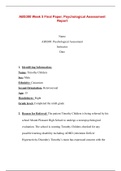Samenvatting
Summary/ Samenvatting Personality Psychology Larsen & Buss
- Instelling
- Hanzehogeschool Groningen (Hanze)
Hierbij mijn Engelse samenvatting voor het boek Personality Psychology: Domains of Knowledge About Human Nature. 4th Edition, International Edition (English Summary). Hier en daar voorzien van nederlandse aantekeningen
[Meer zien]














